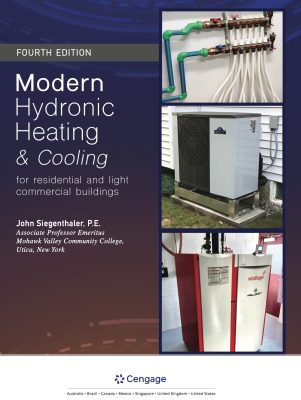Controlled radiant cooling
The Glitch & The Fix, June 2013




The Glitch
An installer plans to use a geothermal heat pump to supply warm water to a multizone radiant ceiling panel system. Having heard that radiant ceiling panels also can be used for cooling, he decides to pump chilled water through the same radiant ceiling distribution system.
Only one cooling zone is need, so all the manifold valve actuators have been wired so that they open at the same time in the cooling mode.
Can you find at least five design errors, omissions or piping details that should be changed in the above Glitch schematic?
The Fix
Radiant ceiling panels can be used for sensible cooling. Doing so requires the proper controls to regulate the supply temperature of the chilled water, relative to the dewpoint temperature of the room air. It also requires a small air handler to handle the latent cooling load (e.g., moisture removal).
Another solution is to select a chilled water air handler as shown in the Fix schematic above. The air handler is equipped with a drip pan and condensate drain. It has been selected and sized to handle the full cooling capacity of the heat pump, and thus does not need to be supplied through a buffer tank.
The multizone space-heating system does need to be supplied through a buffer tank to avoid short-cycling the heat pump. Because valve-based zoning is used, a variable-speed, pressure-regulated circulator is used in the heating distribution system.
The earth loop also needs some attention. Specifically, it should be equipped for air and dirt separation. It also should be equipped with an expansion tank to limit pressure variations within the earth loop between summer and winter operating modes.
Other errors in the original schematic include:
1. No vibration-absorbing flex hoses on load side of heat pump.
2. Circulator mounted very close to connection where highly turbulent flow exits heat pump condenser.
3. Placing the expansion tank with a high flow-resistance element (the heat pump condenser) between tank inlet and circulator inlet. This causes a significant pressure drop upstream of the circulator inlet, which encourages cavitation.
4. The purging valve in the distribution system is installed backwards.
5. No pressure-relief valve is installed for the load side of the heat pump.
Looking for a reprint of this article?
From high-res PDFs to custom plaques, order your copy today!











